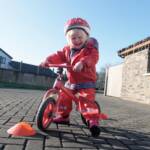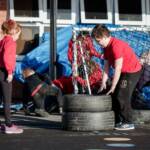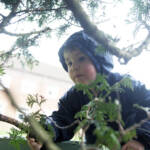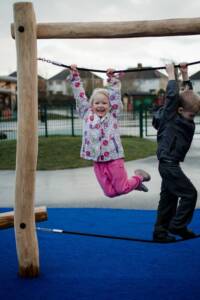
Play Spaces
The quality of play is fundamentally shaped by the environments it happens in. A rich play environment is a varied and safe space, a place which is child-centred and allows children the time to fully immerse themselves in their play.
We recognise that the provision of space for play takes many forms and can include:
- Parks
- Homes
- Gardens
- Public open spaces
- Streets
- Green spaces
- Play centres
- Staffed adventure playgrounds
- Childcare providers
- Schools
Quality play provision offers all children and young people the opportunity to freely interact with or experience the following:
- Other children and young people
- The natural world
- Loose parts
- Challenge and uncertainty
- Changing identity
- Happiness
- Movement
- Rough and tumble
- The senses



Play in Schools
Children’s free time is becoming more and more limited for outdoor play, so playtime in school is important for children as it is time for having fun, relaxing as well as benefiting their health and well being.
The school day should allow time and space for children to relax and play freely with their friends. Children spend a great deal of time in school and for children playtimes are a very important part of the day.

Smoke Free Play Areas
On 1 March, the law around where people can smoke is changing and will mean that hospital grounds, school grounds and public playgrounds, as well as outdoor day care and childminding settings will be required to be smoke-free. Voluntary smoking bans are already in place. Enforcement of this legislation will be via local authorities who will now have the powers to issue fixed-penalty notices.
The Welsh Government’s new smoke-free restrictions aim to protect people’s health from the harms of second-hand smoking and further de-normalise smoking behaviour for children and young people.



Bilingual Communication Boards
The boards have been put up in local parks across Carmarthenshire to support children’s communication whilst they are playing. See the video for more information.
Play and Risk
‘Better a broken bone than a broken spirit’ – Lady Allen of Hurtwood

The Play Policy 2002 notes: ‘children have an innate desire to seek out and take increasing risks.’ From a very young age and from their earliest play experiences children begin to take risks. Children would never learn to walk, climb stairs or ride a bike unless they were strongly motivated to respond to challenges involving a risk of injury. Therefore, quality play provision must provide children and young people with opportunities to take risks.
The benefits of risk taking are that it:
- enables children to test, explore, extend, and refine their capabilities continuously
- gives them a sense of pride and achievement when mastering a new challenge
- is exhilarating and thrilling
- influences their self-esteem, self-confidence, and peer relationships
- enables children to place themselves in situations that have a sense of jeopardy and risk without overexposure to the serious likelihood of harm
- is the perfect training ground for a life full of uncertainty
Facilitating risky play
Within the structure of health and safety, we must remember that risk taking is an important part of a child’s development. However, as adults and carers of children, when we think of the word ‘risk’ it often raises all sorts of concerns and we become little risk averse. When observing/supervising playing children we regularly overreact, looking to the worst-case scenario rather than allowing the observable facts in front of us to inform our judgements, resulting in the unnecessary curtailing of play opportunities. There is a huge difference between putting a child at risk and allowing a child to take risks.
Rather than jumping in and stopping play based on our first reactions, it’s a good idea to take just a second or two more to think:
- What is going on here?
- How is it going?
- Why are the children choosing to do it?
- What are the benefits?
- What risks are children taking?
- Are children being cautious, managing their or each other’s behaviour?
- Given the benefits and the risks do I really need to stop this?
Where there is time to do this (it only takes seconds), we can avoid overreacting, process what may be beneficial and what are the real risks, consider potential options and formulate more reasoned responses and interventions.
For more information follow these links:
Play providers experiences and views on risk and play



